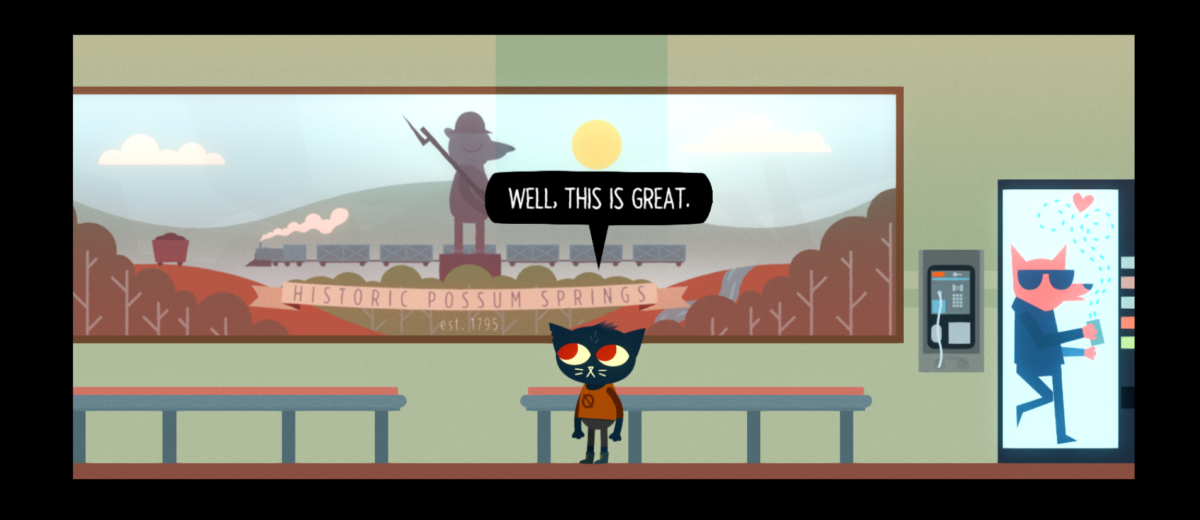Stories of young adult confusion, failure, and existential dread have been popular in video games recently, with Life is Strange and Oxenfree doing quite well, but Night in the Woods does it perfectly. Night in the Woods is the newest title from Infinite Fall, a 3-man team of Alec Holowka, Scott Benson, and Bethany Hockenberry. It’s an atmospheric, spooky game about a bunch of animals dealing with small town life, and uncovering a strange secret. You play as Mae Borowski, college drop-out and all-around trash-fire of a person, returning to her home town of Possum Springs and reconnecting with close friends she hasn’t spoken to in 3 years. However, things have changed. Mae’s having weird nightmares, and her friends have grown up without her.
Night in the Woods is a weird combination of platformer, adventure game, and visual novel, with lots of great minigames mixed in. The main game consists of waking up late and wandering around town until you choose to spend time with one (or rarely, all) of your friends. There’s Gregg, your overly-excitable childhood friend; his boyfriend Angus, who is stoic and frustratingly right all the time; and Bea, a sarcastic alligator who owns the only car in the crew. You spend the day hanging out, and then go home to, a lot of the time, have a cryptic nightmare with a great soundtrack.
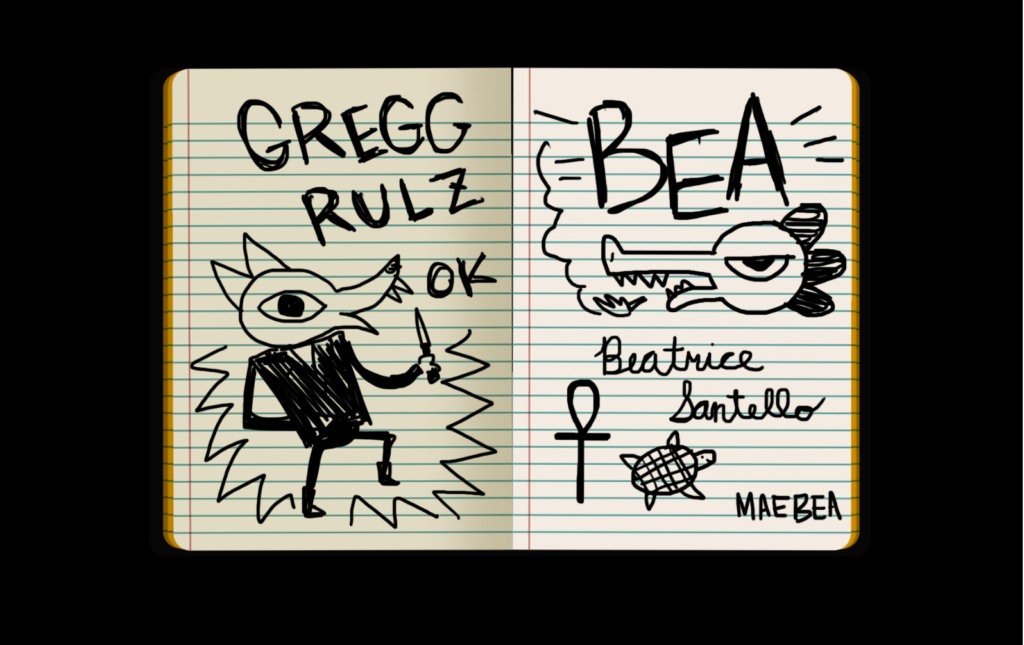
The game shines not in gameplay, but in writing. You move through a rather linear story, but choose how to spend your time on the less important days. One day you’ll be in a Harvest Festival play, and the next you’ll be getting into a knife fight by the lake, followed by an emotional heart-to-heart about how your friend thinks he’s a failure and is dragging everyone around him down with his lack of motivation. You know, stuff 20-somethings do.
The soundtrack and animation are also phenomenal. Each character has their own walk cycle that provides plenty about their personality, with little additions like ear flicks, blinks, and arm wiggles making them seem all that more real.
All the characters are deep enough that you find yourself caring about them quickly. Things that happen feel real, like a fight with your mother is downright upsetting, while quiet chats with your dad before bed, watching mindless TV, is genuinely relaxing, and makes the weird day you had seem better. Mae records characters and interesting things in a journal, and it’s one of the best things about the game. Entries even change with interactions, like, “Dad looks older.” will add, “-but, still funny.” after he makes a particularly good joke. It also provides us with “GREGG RULZ OK”, which will never leave your mind.
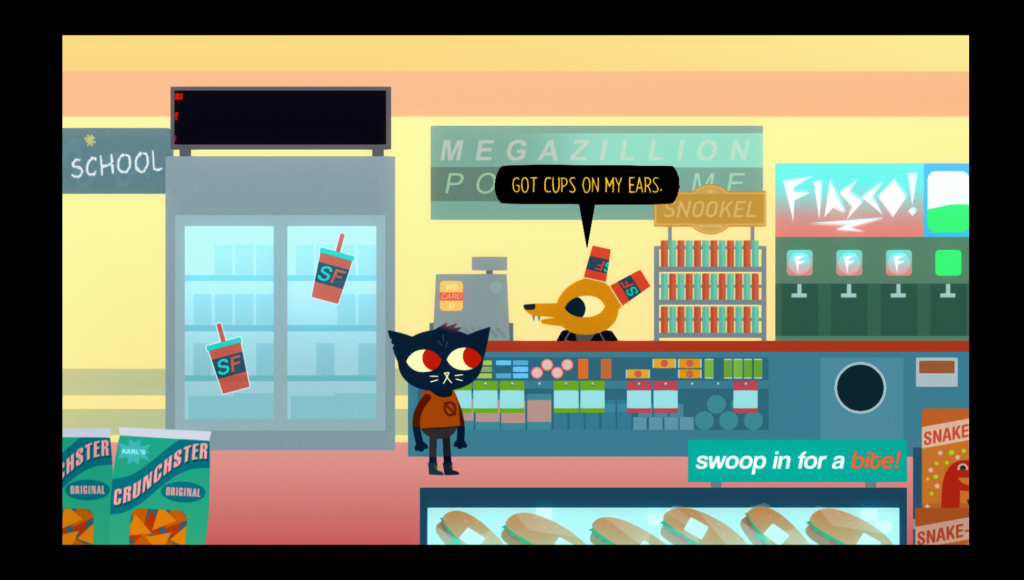
Night in the Woods isn’t so much about the ending, but the interactions you have as you get there. Some of the most interesting parts of the game don’t involve the mystery at all, but talks and fun, and not-so-fun, with your friends. Through them, you learn about Mae, from her high school days, to the incident that people keep mentioning, but is apparently one of Mae’s biggest regrets. Through these daily interactions, however, we see a flaw in the game. You’ll be going through the days, seeing your friends, and you don’t know if you’ll find plot, or if you’ll just be swinging bats at light bulbs in the parking lot of the Snack Falcon.
You do, however, know exactly when the action is about to start, as the game tends to waver at a low spooky-level, and then shoot up to 100. The pacing could use some work, but it doesn’t hurt the experience much. It’s reminiscent of life, showing off monotony as something that isn’t too bad, and you never know what day will change your life.
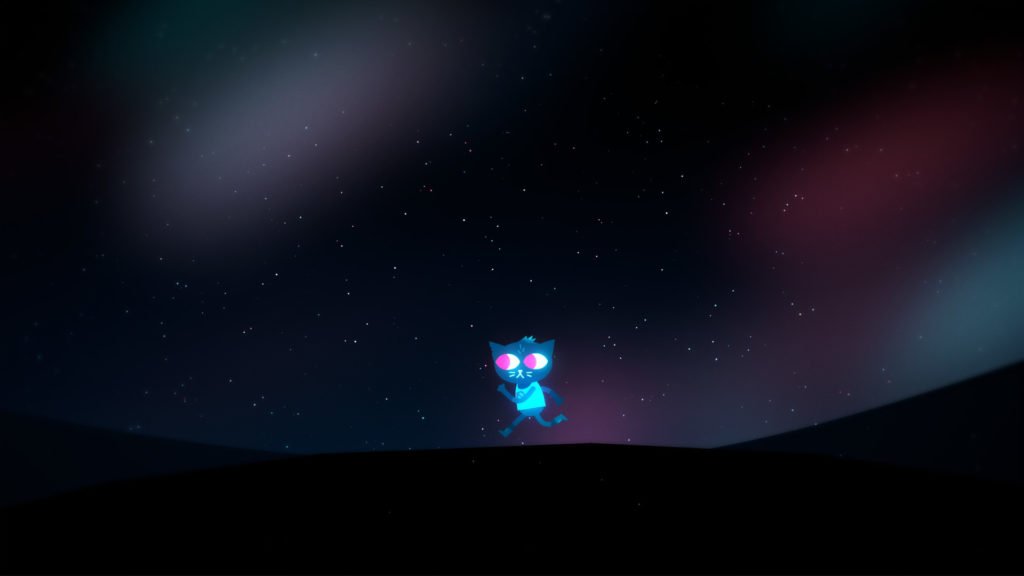
The pop-in for items and objects you can interact with can also be a bit slow, so it’s easy to miss things. You can be scrambling to try to move a scene along, but keep running by the one thing Mae needs to see and comment on before you can move on. You’re also forced to do things that are completely avoidable, but you have to keep doing them to stay “in character” and move on, like being forced to keep drinking at a party before the scene continues on.
It feels like you should be able to enjoy yourself and talk to friends, but the game forces you to drink, interact with everyone, drink, interact, get sloppy drunk, and puke in front of your peers. The game changes dialogue and minor things based on your choices, but when it seems like a large choice is coming, it passes you by.
Though the game may have it’s stumbles, it more than makes up for it in every other regard. It’s beautiful, engaging, and the beginning gives you just enough hints at the overarching story to you push through parts that aren’t exactly 100% fun. There is an entire rogue-like on Mae’s laptop that you can open and play at any time, with its own soundtrack, surprisingly intuitive controls for a game inside a game. There’s also a very responsive Guitar Hero-esque rhythm game in which you play a song at band practice, that Mae explains she has never heard before, which perfectly shows why it’s so hard.
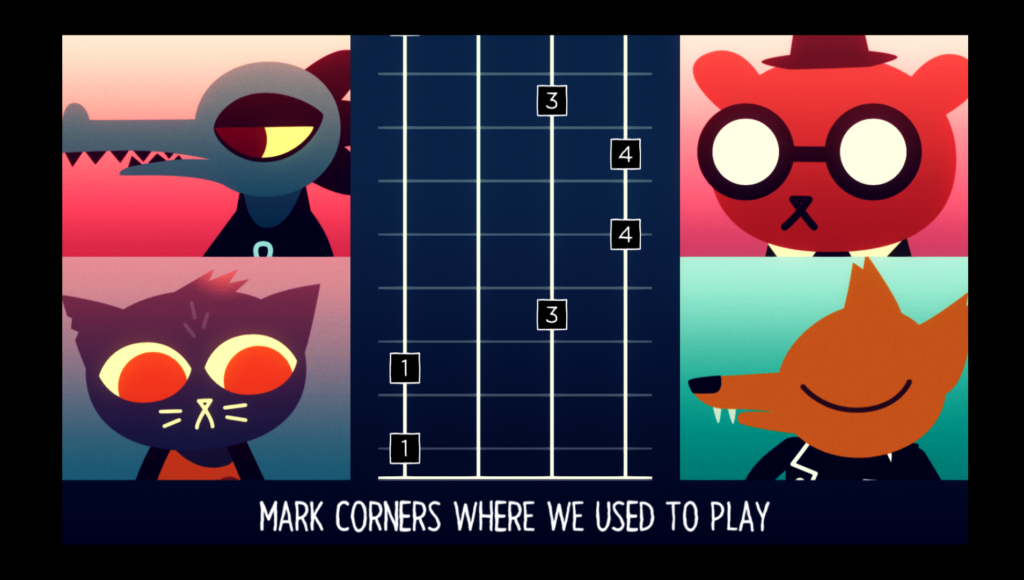
Whether you’re in it for the story, characters, or the pure artistic experience the game provides, there’s something for everyone to love. You find yourself drawn into the world, and relating to characters a little too deeply. None of them are perfect (except for Mae’s dad, who is a treat), and the town definitely isn’t, but that makes them feel all the more real. Your friends are the most important part of the story, and like the tagline says, “At the end of everything, hold on to anything.”
You feel like Possum Springs is a place you could visit, but probably shouldn’t. Maybe Gregg could really be your reckless friend who you knife fight and build terrifying forest robots with. Night in the Woods is an experience that’s difficult to describe, but it’s definitely difficult to put down.
This game was reviewed on PC through Steam, with a copy purchased by the reviewer.
- Charming characters
- Beautiful art and soundtrack
- Engaging story
- Strange pacing
- Gives the illusion of choice


